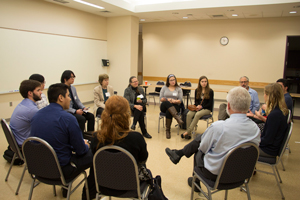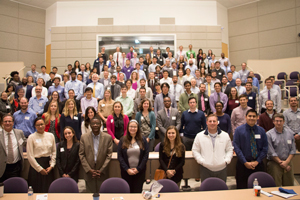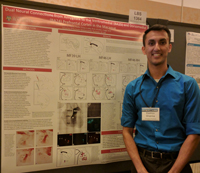Joint Upstate NY MD/PhD Conference and APSA Regional Meeting Mark an Exciting Day for Future Physician-Scientists
Monday, November 13, 2017
Saturday, October 7, 2017 brought over 125 graduate and medical students, MD-PhD students and undergrads to the UR School of Medicine. In conjunction with the Upstate New York MD/PhD Program Conference (annually hosted by either University of Rochester, SUNY Upstate at Syracuse or University at Buffalo MD/PhD Programs), the annual APSA Northeast Regional Meeting was also held. APSA (American Physician Scientist Association) is a national student-run organization for those interested in becoming physician-scientists.
Two keynote speakers presented: Michael Potchen, MD “The Physician Scientist: A Life Journey” and Robin Lorenz, MD, PhD “Perspectives on a career as a physician-scientist”. In addition, breakout sessions were held on MD/PhD Program Admissions, Management 101 for physician-scientists, Partners in Academia, Essentials of Grant Writing and Policy Engagement. During lunch in the Flaum Atrium, a student poster session was held with voting for the best posters.
Six students gave oral presentations on their research as well as women’s health needs in underserved regions. A panel discussion on “The Future of the Physician Scientist” was given by 4 faculty in attendance (Drs. O’Banion, Lorenz, Akabas and Horton). A lively question and answer session took place, followed by closing remarks and poster awards.
Happy hour at a local pub rounded out the successful day. We look forward to seeing everyone again in 2020!


Neurology & Neuroscience Panel Advises Prospective Trainees
Wednesday, October 18, 2017
On Tuesday, October 17, 2017, PONS teamed up with the BCS & Neuroscience Undergraduate Council(BNUC), SIGN, and NSFG to host a Graduate/Medical Student Panel for those interested in pursuing an advanced degree in Neuroscience or Neurology.
About 20 undergraduate attendees asked questions of our panel of Neuroscience PhD, MD/PhD, and Neurology MD students currently enrolled at the University of Rochester's School of Medicine and Dentistry. Our panelists included 2nd Year NGP PhD students Emily Warner and Neal Shah, 1st Year NGP MD/PhD student Karl Foley, and 1st Year MD student Josh Geiger. BNUC Co-President Herman Li and PONS President Holly Beaulac moderated the event.
Each panelist shared their individual journeys including performing undergraduate research, job shadowing/internships, and teaching/outreach opportunities. Topics discussed included strategies for determining the right program for one's interests, standing out as an applicant during admissions/interviews, and being productive while limiting stress when acquiring an advanced degree. We want to thank all of our panelists and attendees for a great turnout and lively discourse!
For more information on upcoming Neuro-events, please visit our homepage
Keshov Sharma Presents Late-Breaking Data at Society for Biological Psychiatry in San Diego
Monday, May 22, 2017

Keshov Sharma, a second-year student in the Medical Scientist Training Program (MSTP), presented work collected in part during his laboratory last summer at the SOBP Annual meeting in May. The study, “Dual Neural Connections between the Amygdala and the Ventromedial (BA25) and Dorsomedial (BA24) Prefrontal Cortex in the Macaque”, was inspired by recent data in rodents implicating separate subcircuits between amygdala and infralimbic cortex, and amygdala and the prelimbic cortex, in fear extinction and fear consolidation, respectively. To find a comparable bridge to human fear studies, we designed studies to examine this question in monkeys because of their relatively larger and more subdivided cortical architecture that parallels the human. Analyzing dual retrograde injections into proposed ‘homologues’ of these rodent cortical regions in monkeys, we found that cells projecting to these cortical regions were mostly intermixed in several specific amygdala subnuclei in primates. Moreover, a subpopulation of neurons projected to both prefrontal regions, indicating common neural modulation of these functionally dissociated areas. Thus, amygdala inputs to separable, functionally opposed cortical regions exist in close proximity to one another in specific parts of the amygdala, and some of these cells participate in both ‘subcircuits’. Understanding this organization may provide clues about how to ‘tip the balance’ between fear learning and fear extinction learning in higher species, including humans that suffer from illnesses characterized by aberrant fear learning.